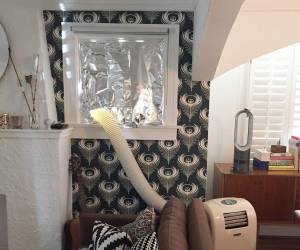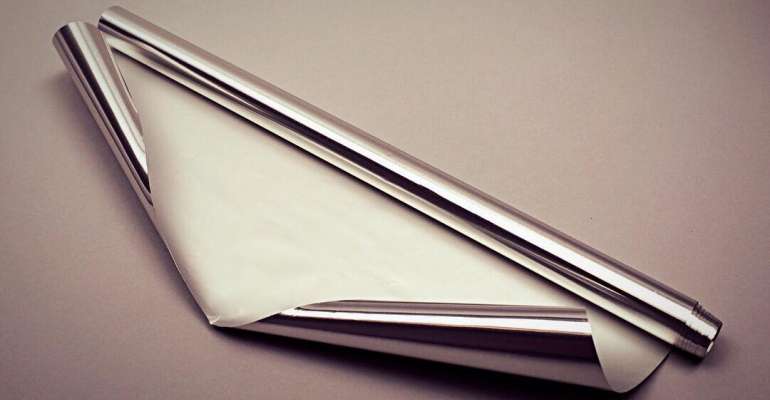Those mid-summer or late summer air conditioning bills can be brutal. The cost of keeping your home reasonably cool in the summertime rises dramatically with each new heat wave; and if you live in an area of the country where the hot weather starts early and stretches on well into fall, you may feel like you are out of luck when it comes to trying to save money on air conditioning or climate control. That’s why some people resort to extreme measures—like putting aluminum foil on windows.
You may have heard of this practice, or seen it done. Maybe you thought it was terribly ugly, not aesthetically pleasing at all, or maybe you thought, “What a great idea! I wonder if it works!” We are here to answer that question.
Does putting aluminum foil on windows actually keep the heat out? If not, why do people do it? And if it does have some benefits, what is the best type of foil to use and the best way to keep it in place? Is there another solution that could work better than aluminum foil on windows? We’ll tackle all those topics and more as we move forward.
Does Aluminum Foil Keep Heat Out?
Aluminum foil, or tin foil as it is often called, is primarily intended to provide heat-proof, air-tight, safe coverage for food. It’s popularly used to cover hot foods, to provide a protective barrier over baking trays or dishes during the cooking process, or to package certain types of meals, candies, or other items. Aluminum foil keeps out odor, moisture, germs, oxygen, and light, which could contaminate food. It also locks in any desired moisture, scent, and flavor.
 As far as keeping the heat out of a home, there’s no proof that aluminum foil on its own is particularly effective at this task. Sure, it will reflect some light away, preventing it from entering the home. However, the foil itself does heat up over time, so the extra heat isn’t necessarily all bouncing away into the air. Some of it is still getting inside.
As far as keeping the heat out of a home, there’s no proof that aluminum foil on its own is particularly effective at this task. Sure, it will reflect some light away, preventing it from entering the home. However, the foil itself does heat up over time, so the extra heat isn’t necessarily all bouncing away into the air. Some of it is still getting inside.
Aluminum foil on windows is most effective at keeping out heat and light when you place it shiny side out and cover its backside with a layer of something else, like insulation or cardboard.
Health Concerns About Tin Foil
Some people are worried that using tin foil or aluminum foil on their windows could cause serious hazards. Fortunately, there is no indication that using foil over windows is dangerous.
The heat of the sun cannot melt the aluminum foil—it is tough enough to handle high oven temperatures, so it can certainly handle the power of summer sunlight. And being exposed to heat will not radiate harmful toxins into your house when it’s exposed to sun and heat, either.
 After all, if that was the case, it wouldn’t be approved for common use around food. Unless you ate a lot of aluminum or breathed in a lot of aluminum dust generated by machines in a factory, aluminum can’t hurt you. So it’s perfectly safe to use tin foil on windows if that’s your preference.
After all, if that was the case, it wouldn’t be approved for common use around food. Unless you ate a lot of aluminum or breathed in a lot of aluminum dust generated by machines in a factory, aluminum can’t hurt you. So it’s perfectly safe to use tin foil on windows if that’s your preference.
Some have also suggested that using a lot of metal foil on windows might cause a building to be a target for lightning strikes. The science just doesn’t support this. The foil behind the glass on your windows has no effect on guiding lightning bolts at all. It does not attract or repel them, so there is no cause to worry on that account.
Other Reasons to Use Aluminum Foil on Windows
Some people may put aluminum foil on windows in winter. They’re not necessarily trying to reflect the heat of summer out of the home; they are probably taking advantage of the tin foil’s other properties. Let’s look at a few more reasons why homeowners might choose to cover windows with aluminum foil.
Glare Protection
 If you live in a home where the sun tends to come in at a particular angle that causes severe glare, you may be interested in finding an inexpensive way to keep that from happening on a regular basis. The position of the sun as its beams surge into the home might be interfering with the use of a bathroom mirror in the morning, or with the viewing of the TV at noon, or with regular dishwashing and cleanup chores in the kitchen at sunset.
If you live in a home where the sun tends to come in at a particular angle that causes severe glare, you may be interested in finding an inexpensive way to keep that from happening on a regular basis. The position of the sun as its beams surge into the home might be interfering with the use of a bathroom mirror in the morning, or with the viewing of the TV at noon, or with regular dishwashing and cleanup chores in the kitchen at sunset.
Whatever the annoyance the glare may be causing, for some people, it’s easier to quickly slap a sheet of aluminum foil over the offending window pane to block out the glare.
Room Darkening
 Some people put aluminum foil on windows to keep light out. Individuals who work third shift or some other type of shift that necessitates sleeping while the sun up often has to resort to extreme measures to ensure that their bedroom is dark enough to allow them to sleep. Room-darkening shades or blinds or curtains can be very expensive, so some renters or homeowners choose a quick, temporary, easy, and cheap solution.
Some people put aluminum foil on windows to keep light out. Individuals who work third shift or some other type of shift that necessitates sleeping while the sun up often has to resort to extreme measures to ensure that their bedroom is dark enough to allow them to sleep. Room-darkening shades or blinds or curtains can be very expensive, so some renters or homeowners choose a quick, temporary, easy, and cheap solution.
They simply plaster the windows in the bedroom with tin foil to effectively seal out light and create a room darkening effect. The aluminum foil can go all the way to the edges of each window pane and fit closely and tightly against the glass, enabling a better seal and a more thorough blocking out of any potential stray bits of light.
Privacy
 Window coverings, in general, are intended, at least partly, to provide a form of privacy when it is needed. However, window coverings like blinds, shades, drapes, curtains, and shutters can be quite expensive, especially if your home has a lot of windows to cover. Maybe you simply don’t have that kind of money right now, and you need a quick, easy solution to provide the privacy you need while you’re saving up for the window treatments you really want.
Window coverings, in general, are intended, at least partly, to provide a form of privacy when it is needed. However, window coverings like blinds, shades, drapes, curtains, and shutters can be quite expensive, especially if your home has a lot of windows to cover. Maybe you simply don’t have that kind of money right now, and you need a quick, easy solution to provide the privacy you need while you’re saving up for the window treatments you really want.
 Or maybe you actually do have the money on hand for curtains, blinds, or shades, but you are waiting on ordering them because you haven’t quite decided on the decor you’d like for that room yet. While you’re pondering the overall aesthetic of the room, you might need a quick temporary solution to cover those windows.
Or maybe you actually do have the money on hand for curtains, blinds, or shades, but you are waiting on ordering them because you haven’t quite decided on the decor you’d like for that room yet. While you’re pondering the overall aesthetic of the room, you might need a quick temporary solution to cover those windows.
After all, you don’t want passersby peeping into your bedroom when you’re asleep or observing you as you dance with your significant other in the kitchen or lecture your kids about homework. Privacy is important, after all, and you shouldn’t have to forgo it just because you’re not ready to invest in window treatments. Aluminum foil works better than paper to thoroughly cover window panes. Where paper might turn see-through when there is a bright enough light behind it, tin foil on windows provides more opaque coverage.
Putting Tin Foil on Windows
So how do you put the tin foil on your windows? We’ll go through a few important steps in the process so you can know how to best make use of this unique household product.
Purchase an Ample Supply

Tin foil is fairly cheap—much cheaper than a set of blinds or curtains. Buy a few boxes of it and spring for the high-end, quality stuff, not the cheapest box on the shelf. If you go too cheap, the foil will tear way too easily, and you will become very frustrated as you try to apply it to your windows. It is a good idea to spend a few extra bucks and score boxes of aluminum foil that will actually hold up during installation and will last for a good long while.
Measure Your Windows

You can do this step after you’ve already purchased a few boxes of tin foil, or you can measure your windows first to ensure that you buy enough square footage of foil for the surface area you need to cover. If you’re just doing a couple of smaller bedroom windows, you won’t need much tin foil; but if you are planning to use tin foil to cover all the windows throughout your home, you will definitely need a lot more of the material.
Measure the length and width of each window you plan to cover. Multiply the length times the width to get the area of the window, the square footage of the space you need to cover with foil. Keep in mind that the foil won’t need to cover the frame or any window trim pieces—just the glass.
Once you have the area of the window, write it down and repeat the process for every other window you plan to conceal with aluminum foil. Make a list of the area of each window, in square inches or square feet. Add the area numbers together to get the total square footage of all the windows in your home. That’s the number of square inches or square feet of foil you will need. However, it’s a good idea to purchase extra foil in case some of it gets ripped or punctured during the cutting or installation process.
Cut and Tape the Foil

Measure and carefully cut or tear-off sheets of the aluminum foil to fit the window panes that you need to cover. You can shape or cut to fit the exact size or shape of the windows. Be sure to add painter’s tape or some other sticky yet wall-safe tape along the edges of the foil, to secure it in place. Occasionally you may have to replace the foil and the tape, as the tape may lose its stickiness over time through exposure to heat and light.
While there’s nothing inherently wrong with using aluminum foil on windows, it can be a distraction to passersby. Glare from the metal sheeting could distract drivers, or make your neighbors really curious about what suspicious activities might be going on in your home. Your guests, family, friends, and neighbors might also dislike the odd look of the foil. It definitely can have a negative effect on curb appeal, so it may be wise to look at the foil as a short-term stop-gap rather than a long-term solution.
- Using Borax in the Dishwasher - May 27, 2020
- Towel Ring Height and Other Fixtures: Proper Measurements - May 1, 2020
- Homemade Paint Removers for Every Surface - April 27, 2020

JJ
Thursday 27th of July 2023
My idiotic Landlord decided to put up a greenhouse on the roof of the house as a vanity project, he has never even stayed in the property.
Massive floor-to-ceiling glass 20M x 15M, you may say well that's his prerogative.
They thought it would be aesthetically pleasing not realising that the temperatures inside would reach 50C on the roof and 27-30C inside the upper floors with the AC running full blast.
We are in south China where temperatures regularly hit the high 30s in summer.
I have just installed reflective fabric which was cheaper than tinting the windows, but will consider this if it fails.
Tristan
Monday 28th of November 2022
We used the foil on the windows, spraying water on the windows first which helped the foil easily stick to the windows. When removing the foil it left a residue on them which we have been unable to remove.
Do you have any tips on what to do to remove it from the glass window?
Joe
Saturday 4th of February 2023
@Tristan, steel wool and windex
Sean
Monday 19th of July 2021
I have put tin foil on the inside of my windows, shiny side facing out, and then cardboard behind that, and I have to say it's still really hot in here so I don't think this really works at all.
Krew C.
Monday 14th of June 2021
It would be definitely be much EASIER to use cardboard (or those foam boards from the Dollar Tree) as a solid surface to attach the foil and fabric...... cover the side facing out with the foil and the interior-facing side gets the fabric. It would be easy to cut and fit the pieces to your window, making a neat appearance on both sides, the foil won't tear so easily, and you can put them up, take them down and reuse them, needing only to replace the foil if it deteriorates from sun exposure. I'm not sure how you plan to attach fabric to the foil alone, with nothing solid in between the two. Whatever you have in mind for that, I doubt you'd be creating a fire hazard as long as you don't use a flammable adhesive. (Check the labels for flammability info.)
Sandy R Etanislado
Monday 28th of December 2020
I was wondering if i cover half of my bedroom windows and the backside side of the houses windows, could i put some kind of Fabric on the foil facing inward? You know for example,my sons room. He has things like batman or marvel comics. Could i use fabric of that kind to put on their so it wouldnt look so awkward? Or maybe a different pattern for my living room windows?
Amanda
Tuesday 15th of June 2021
It would be better to use cardboard or a few layers of thick white cardstock.
Chad
Sunday 13th of June 2021
Sandy, I suppose it may depend on how much heat the fabric can stand (don't use something extremely flammable) - if I were you, I'd put cardboard between the aluminum foil and the fabric. I've used pieces of cardboard with aluminum foil on them in my west-facing windows for years, without any issues, and I had to take them out in the evenings because they weren't allowed to be permanent (apartment rules.) I don't recall them between all that hot when I took them out in the evenings, so you may not even have a concern - maybe try them WITHOUT the fabric first, and if the cardboard backing that the fabric will be sticking to doesn't seem too hot after many hours of hot sun, then go ahead and put the fancy fabric on there, maybe leaving a little room on the edges and corners, so as to not tempt fate - ha! Good luck!